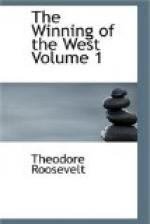13. In the Haldimand MSS., Series B, Vol. 122, p. 3, the letter of M. Ste. Marie from Vincennes, May 3, 1774, gives utterance to the general feeling of the creoles, when he announces, in promising in their behalf to carry out the orders of the British commandant, that he is “remplie de respect pour tout ce qui porte l’emprinte de l’otorite.” [sic.]
14. State Department MSS., No. 48, p. 51. Statement of M. Cerre (or Carre), July, 1786, translated by John Pintard.
15. Do.
16. State Department MSS., No. 48, p. 41. Petition of J. B. La Croix, A. Girardin, etc., dated “at Cohoe in the Illinois 15th July, 1786.”
17. Billon, 91.
18. An arpent of land was 180 French feet square. MS. copy of Journal of Matthew Clarkson in 1766. In Durrett collection.
19. American State Papers, Public Lands, I., II.
20. Fergus Historical Series, No. 12, “Illinois in the 18th Century.” Edward G. Mason, Chicago, 1881. A most excellent number of an excellent series. The old parish registers of Kaskaskia, going back to 1695, contain some remarkable names of the Indian mothers—such as Maria Aramipinchicoue and Domitilla Tehuigouanakigaboucoue. Sometimes the man is only distinguished by some such title as “The Parisian,” or “The Bohemian.”
21. Billon, 90.
22. Letter of P. A. Lafarge, Dec. 31, 1786. Billon, 268.
23. State Department MSS., No. 150, Vol. III., p. 519. Letter of Joseph St. Mann, Aug 23, 1788.
24. Do., p 89, Harmar’s letter.
25. Do., p 519, Letter of Joseph St. Marin.
26. Do., p. 89.
27. Journal of Jean Baptiste Perrault, in 1783; in “Indian Tribes,” by Henry R. Schoolcraft, Part III., Philadelphia, 1855. See also Billon, 484, for an interesting account of the adventures of Gratiot, who afterwards, under American rule, built up a great fur business, and drove a flourishing trade with Europe, as well as the towns of the American seaboard.
28. State Department MSS., No. 48, p. 25. A petition concerning a case in point, affecting the Priest Gibault.
29. “History of Vincennes,” by Judge John Law, Vincennes, 1858. pp. 18 and 140. They are just such carts as I have seen myself in the valley of the Red River, and in the big bend of the Missouri, carrying all the worldly goods of their owners, the French Metis. These Metis,—ex-trappers, ex-buffalo runners, and small farmers,—are the best representatives of the old French of the west; they are a little less civilized, they have somewhat more Indian blood in their veins, but they are substantially the same people. It may be noted that the herds of buffaloes that during the last century thronged the plains of what are now the States of Illinois and Indiana furnished to the French of Kaskaskia and Vincennes their winter meat; exactly as during the present century the Saskatchewan Metis lived on the wild herds until they were exterminated.




